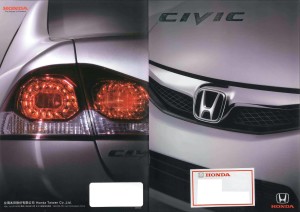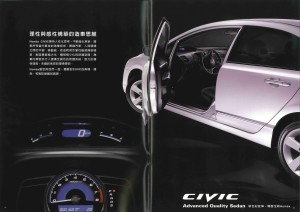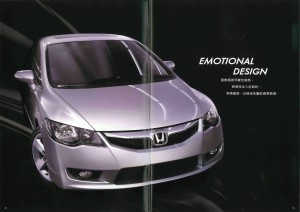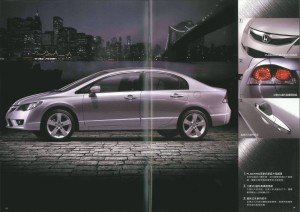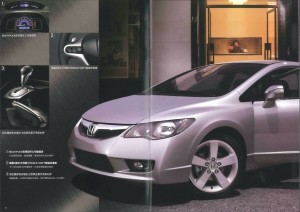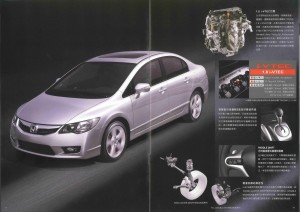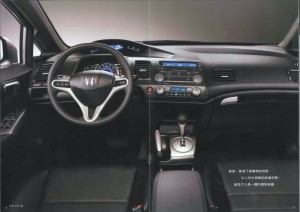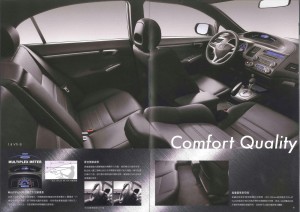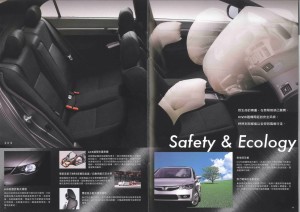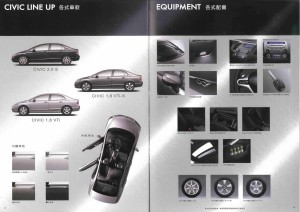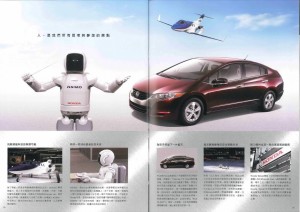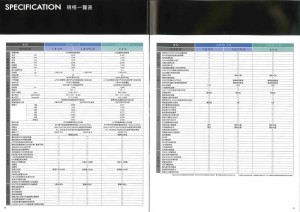Why I Love Honda Civic 8
I have always been a fan of Volkswagen, but I never had the fortune to own a Volkswagen. They’re too expensive for most Taiwanese. For me, Japanese cars are more viable. We’ve tried out a few makes, including Toyota, Mitsubishi, Nissan, and Honda. In fact, we’ve been driving Honda more than the other brands. I can’t say that I am impressed by Toyota or Mitsubishi. Mitsubishi impressed me the least. Toyota was good at first, but turned out to be slow in response and boring to drive. Toyota was nonetheless painless to own, and seriously, as a car, it does its job well.
When it comes to fun, Honda is placed among the top of my list among the Japanese brands. Their small to compact car range is somewhat affordable, although a bit more expensive than Toyota or Nissan in the same class. Once you own a Honda, however, you’ll see that the extra cost is worth it.
My father owns a Honda Civic 8, and I sometimes get to drive it around. It’s always a joy to drive a Honda Civic 8. I helped him make the choice when buying this car. A friend, who is a car mechanic, told me that Civic 8 sells even better than Civic 9 for some reason. He’s driven our car, and he loves it too.
So what is there to love so much about Honda Civic 8?
1. Awesome Passive Safety
Honda Civic 6 and before were tin-can cars. If they crash, they crumple, and the people inside will be squashed. Volkswagen New Beetle was the first small car to have ever made very high score in crash test safety. It set the benchmark. Then came Honda Civic 7. Out of nowhere, Honda Civic transformed from a tin-can to a super tank in crash tests. The crumple zone worked as in all cars, but the safety cage of Civic 7 was almost unmoved, unbent, and very much intact. The dashboard moved very little after the crash. Driver and passenger space was excellent, so good in fact, it surpassed New Beetle’s benchmark record. Honda Civic 7 was the safest small car in crash tests.
Thankfully, Honda Civic 8 retained that excellent legacy. When the car was introduced, small overlap frontal crash test was not required. Frontal car crash test comes in mainly 3 types. One is a full-on crash test, which means the entire width of the car crashes into a wall. The whole cage of the car will take the impact, so the result is not bad in most of the cars, because energy is distributed quite evenly across the entire structure. Then moderate offset frontal crash test was introduced, meaning the car would have to crash into the wall with only 40% of its width taking the full impact. The test always chooses the driver’s side for the half of the car that will take the impact. Lots of small cars failed in this area. The test was more strict than before.
Recently small frontal impact was added to the norm. Small frontal impact uses only 25% of the driver’s side to crash into the wall. This means an even smaller portion of the safety cage needs to take the full impact. Again, many cars that performed well in moderate frontal impact failed miserably in the small frontal impact test.
When Honda Civic 8 was introduced, only moderate frontal impact was required in crash tests. This means Honda would have designed Civic 8 to perform well under such circumstances. Here is where I am deeply impressed with Honda. After small frontal impact was introduced, Honda Civic 8 was put under the same rigorous test. It performed very, very well. The only part is that the driver’s leg that’s closest to the door may suffer some injury, but the rest is great. It was excellent among small cars. Almost every detail was highly rated, and the overall result was very good. Regardless of the official safety requirement in its era, Honda really made the effort to build a safe car, surpassing even the standard by miles.
2. Awesome Dashboard Design
The dashboard is designed in two layers. Honda calls it “two-tier instrument”. The top tier provides the most essential gauges, such as the speedometer, fuel gauge, and temperature gauge. Tachometer and other data are provided in the bottom tier. It not only makes the dashboard look cool, as if space tech, but it’s practical in active safety as well. The top layer allows the driver to look down at a much smaller angle than would otherwise be, thus requiring the driver to spend less time looking away from the road, allowing the driver to maintain maximum situation awareness, or even partial situation awareness when looking at the dashboard. Not to say, the driver no longer has to look through the steering wheel to gather the most essential data. This design is closer to having a head-up-display (HUD) like a jet fighter pilot.
The speedometer is placed at the center and it is not a dial in a gauge. It is presented in large, highly visible numbers. It is very easy to track, and very quick to view. Gathering information from the car is quick and effortless.
3. Internal Space
The car is fairly spacious. It is not the most spacious in its class, but it is pretty good already. Leg room and shoulder room are sufficient, and there are many places to store goods. The cup holder at the center is designed so that it can hold small cups, but also large bottles. The arm rest in the center between the front seats can slide forward or be pushed back. It is also the lid for an even larger storage space. There is also another storage space just under the multimedia and air conditioner control panel. The glove box on the passenger’s side is of decent size, and the doors have large holders that can hold a book or a map and even more added to them.
Boot / trunk space in Civic is not bad. You get more than 485 liters of space. That’s big in a small car. However there are a couple of things I find a little annoying. Literally, a “couple” of things. Usable trunk space is great until you really fill it up. The speakers in the rear are placed on the rear shelf silencer. The bottom of the speakers intrude the boot space. When you fill the boot up, the speakers get in the way, and you can’t really fill it to the top. Bigger cartons sometimes fail to fit because of the speakers. Otherwise, the trunk is quite big, and the 4/6 folding rear seat increases Civic’s cargo capacity.
4. Fuel Consumption
Fuel consumption in Civic 8 is awesome. My father’s Civic is a 1.8-liter engine. The automatic gearbox comes with 5 gears ratios, which is a bit more than the traditional 4-gear-ratio design. Normal cars rev at around 2,500rpm when traveling at 100km/h (or 62 mph). Civic 8 revs at around 2,000rpm thanks to its extra gear ratio. This makes it very, very fuel conservative on the freeway.
I like to drive in a fuel-conservative fashion. The official report says that Civic 8 has a fuel consumption rate of 17.91km/L. My highest record is 25km/L, and I frequently better the record of 20km/L on the freeway. In the city, the official report says 9.41km/L. I usually do around 11~12km/L. Civic 8 is an impressively fuel-conservative car.
5. Handling and Active Safety
Need I say more of Honda Civic’s famous handling properties? Why do people buy Civic? It’s mostly because of the handling. This is why there are so many people who love buying Honda Civic and modifying it. Honda makes Civic a non-sports-car sports car. Type-R with 2.0-liter engine is a sports car, but not 1.8-liter versions. Civic 1.8-liter versions take about 10~11 seconds to reach 100km/h or 62mph. That is sedan class. If it takes 8 seconds, or even less, than it can be considered a sports car. Cars like Lamborghini and Porsche are super cars. They’re different.
No, our Civic is nowhere near sports car. But it handles like one – smaller steering wheel, clearer road feel, very agile and accurate steering, and comfortable but firm chassis to make the tight turn. You effectively have a highly agile, sports-oriented car with great feedback and split-second response, yet Honda manages to maintain comfort throughout the ride. You feel the bump, but it is not uncomfortable. The chassis feels rigid, but it cushions irregularities on the road well. Honda gets the right balance.
The car also comes with active safety, such as EBD (or EBFD, electronic brake force distribution), ABS (anti-lock brake system), etc. In terms of active safety, the most ignored but perhaps the most frequently used and important are the headlamps. Civic’s headlight is very bright, and when high bream is switched on, the low breams are not switched off, so it increases the brightness significantly. Fog lamps are extremely helpful especially in the mountain roads, because they broaden the vision so significantly you can see objects at 90 degrees to the head of the car or gutters just beside the headlights. This is great active safety. With high beam, low bream, and fog lights all on, you get really, really bright and broad view in the dark.
There isn’t much to pick on Honda Civic’s handling or safety. Read professional reviews written by car magazines, and you’ll see Civic’s handling is always one of the top cars when compared with many cars of the same class. Handling is always a joy with Honda. If you add turbo to the engine, then it readily becomes a sports car without much tuning. It’s ready as a sports car, but poses as a family car. That is how I see Civic.
6. Engine
No, you wouldn’t think a 1.8-liter engine is worth talking about? No, I’m not going to talk about VTEC. It is already a very famous technology. The engine has the quiet sound of high-pitch smooth mechanism that craves for high revs. Even my wife loves the sound of Civic’s revving engine. The engine is interesting. From my experience with 1998 Toyota Tercel and Toyota Windom (equivalent to that os Lexus ES300), the engine’s torque becomes more obvious at around 2,250rpm, and acceleration becomes acceptably quick on the road. Go higher, and it would consume more fuel, and it doesn’t really save too much of your time because of the many traffic lights you will run into. Yet with Honda Civic 8, the torque isn’t obvious until around 2,500rpm. The engine seems to find it harder to rev up when it’s below 2,500rpm, and when it reaches 2,500rpm, it soars.
This comes to an interesting phenomenon. I find that if I try to save fuel in the city by revving below 2,500rpm, my acceleration is not keen (although not slow compared to other cars on the road) and my fuel consumption gets worse. If I always rev up to 2,500rpm for acceleration, the car’s fuel consumption becomes much better. Not to say, you accelerate quite a bit faster than most cars on the road. Civic’s sports-car nature in its blood reigns here. You HAVE to drive fast to drive efficiently! That is one unusual beast
On the freeway, however, the torque at 2,000rpm seems quite sufficient to keep the car going at a constant speed, even when going slightly up slope. It is a very interesting design.
7. Transmission
The automatic transmission gearbox developed by Honda is awesome. Awesome. Gearshift is always instant – and you can feel it working. It’s almost like the moment you’re thinking about it, the gear shift has been done for you. Some probably don’t like to feel the gears shifting, but unless you really observe it, it’s not that obvious, really. It’s just a bit more obvious than Toyota or Nissan.
Toyota’s gear shift is like, “Oh, I think I feel your full-depth kick-down on the accelerator, but are you sure you’re going to do that? Do you really want me to shift down a gear to make the car accelerate faster? Are you sure? I’m not sure if you’re sure? You’re really really sure? Okay please wait. Oh, I’m doing it right now. Okay, it’s getting in there. Phew, finally done!” And that is if you’re lucky enough the car behind you hasn’t bumped into you yet.
Nissan’s gearbox will be talked about later in a post I will share about Nissan Versa / Tiida. Working with it has been a joyful experience.
The car we have is Civic VTi-S. The S is Sport version, with the main difference being the S-mode transmission with paddle shift behind the steering wheel for manual gear selection. When in normal driving mode, there is no manual gear selection. The torque converter is stiffer and the engine power is transmitted more directly to the wheels. Gear shift is direct and quick to respond.
In Sports mode, the engine power doesn’t increase, but the torque converter changes mode. The engine is free to rev at a higher RPM (revolutions per minute) without being dragged by the weight of the car. This means the engine can rev higher and release its higher torque and power before the car accelerates accordingly. If it’s going up slope, for example, and you’re in normal mode, then pressing down the accelerator wouldn’t do much to increase the engine’s rev unless the gear shifts down to a lower gear. This is because the weight of the car is dragging the engine down, preventing it from revving higher to release more power. In Sports mode, however, the torque converter allows the engine to rev up higher without being dragged by the car. Once revved up higher, the torque converter transmits the engine power and the car climbs up slope more effortlessly, all done without having to go down a gear.
This means in Sports mode, the engine’s power can be utilized to a higher degree of efficiency. If acceleration is needed, the engine will be able to respond more quickly, and help the car out of trouble. The car’s response is elevated in Sports mode, while as the normal driving mode allows the car to save more fuel. Honda provides the best of both worlds.
I place a lot of emphasis on transmission because the output of power and torque of the engine is the same. How the engine’s power is utilized depends on the design of the gearbox. With well-designed transmission, even a car with underpowered engine can be fun to drive.
8. Overall Quality
The overall quality of Honda is great. Even the multimedia set it comes with is of high quality. The radio quality surpasses that of Toyota or Nissan. Everything feels solid.
Conclusion:
It is no wonder why Honda Civic usually gets really good reviews. There isn’t much to pick on it. We’ve owned the car for more than 7 years now, and it is still a joy to drive. It is one of my favorite cars.
(Sorry I only have the Chinese version of the catalog and not in PDF format.)
Written on March 27, 2015 at 4:39 pm


